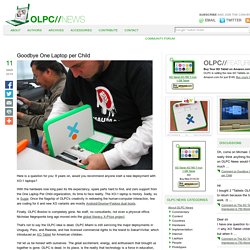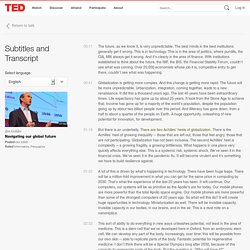

Microsoft HoloLens: Partner Spotlight with Case Western Reserve University. Introducing Oculus Medium. Lytro Immerge. Loon for All – Project Loon – Google. Novartis and Google to Work on Smart Contact Lenses. Pattie Maes + Pranav Mistry: Meet the SixthSense interaction. Paul Conneally: Digital humanitarianism. Eric Topol: The wireless future of medicine. George Whitesides: A lab the size of a postage stamp.
Omni Processor in Senegal. Janicki Omniprocessor. Susan Blackmore: Memes and "temes" William Kamkwamba: How I built a windmill. Sugata Mitra - Beyond the Hole in the Wall - AERO Conference 2015. Sugata Mitra: Kids can teach themselves. Richard Wilkinson: How economic inequality harms societies. The One Laptop Per Child Model Never Was Valid. Alexandra Draxler Is the OLPC model still valid?

It never was valid, at least not for the target group it was aimed at, and that hasn’t changed. There are so many things wrong with the OLPC model that it is hard to know where to begin, but let me try to summarize. Let’s look at objectives, means, cost-effectiveness, implementation, and alternatives. Objectives What is the problem to which OLPC was the solution? Certainly, users were in general favorable, due to the well-documented Hawthorne effect, which wears off over time. Means OLPCs pedagogical usefulness was always deemed by OLPC to be self-evident, which it is not. The arrogance and ignorance of the assumption that the presence of laptops would instantly transform young children into autonomous, disciplined seekers of knowledge and understanding was always evident. Cost-effectiveness One laptop cost $200, not counting connectivity, maintenance, training, replacement.
Implementation. Educational Technology Debate. Goodbye One Laptop per Child. Here is a question for you: 8 years on, would you recommend anyone start a new deployment with XO-1 laptops?

With the hardware now long past its life expectancy, spare parts hard to find, and zero support from the One Laptop Per Child organization, its time to face reality. The XO-1 laptop is history. Sadly, so is Sugar. Once the flagship of OLPC's creativity in redrawing the human-computer interaction, few are coding for it and new XO variants are mostly Android/Gnome+Fedora dual boots. Finally, OLPC Boston is completely gone. That's not to say the OLPC idea is dead. Yet let us be honest with ourselves. So take a moment to mourn the loss of OLPC, and then join us for the larger Educational Technology Debate on where all ICT4Edu efforts are going. PS: A hearty shout-out to Mike Lee, Christoph Derndorfer, Brian Berry, Yama Ploskonka, Jon Camfield, and all the rest who made this journey the ride of a lifetime. Nicholas Negroponte: Taking OLPC to Colombia. Nicholas Negroponte: One Laptop per Child, two years on. One Laptop per Child. Ian Goldin: Navigating our global future.
The future, as we know it, is very unpredictable.The best minds in the best institutionsgenerally get it wrong.This is in technology.

This is in the area of politics,where pundits, the CIA, MI6 always get it wrong.And it's clearly in the area of finance.With institutions established to think about the future,the IMF, the BIS, the Financial Stability Forum, couldn't see what was coming.Over 20,000 economistswhose job it is, competitive entry to get there,couldn't see what was happening. But there is an underbelly.There are two Achilles' heels of globalization.There is the Achilles' heel of growing inequality --those that are left out, those that feel angry,those that are not participating. Globalizationhas not been inclusive.The second Achilles' heel is complexity --a growing fragility, a growing brittleness.What happens in one place very quickly affects everything else.This is a systemic risk, systemic shock.We've seen it in the financial crisis.
Tiny URL to Pearltree.